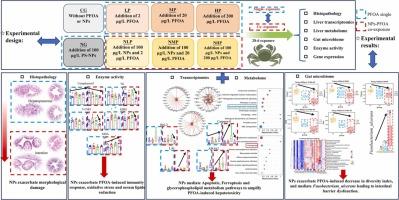Polystyrene nanoplastics amplify the toxic effects of PFOA on the Chinese mitten crab (Eriocheir sinensis)
IF 12.2
1区 环境科学与生态学
Q1 ENGINEERING, ENVIRONMENTAL
引用次数: 0
Abstract
Nanoplastics (NPs), the final form of degraded microplastics in the environment, can adsorb PFOA (an emerging organic pollutant in recent years) in several ways. Current research on these has focused on bony fishes and mollusks, however, the combined toxicity of PFOA and NPs remains unknown in Eriocheir sinensis. Therefore, the effects of single or combined exposure to PFOA and NPs were investigated. The results showed that NPs aggravated PFOA exposure-induced oxidative stress, serum lipid disorders, immune responses, and morphological damage. DEGs altered by NPs-PFOA exposure were predominantly enriched in GO terms for cell lumen, and organelle structure, and KEGG terms for spliceosome and endocrine disorders-related diseases. Notably, the apoptotic pathway plays a central role enriched under different exposure modes. PFOA or NPs-PFOA exposure disrupted the levels of lipids molecules-related metabolites by mediating the glycerophospholipid pathway, and the NPs mediated the ferroptosis pathway to exacerbate PFOA-induced metabolic toxicity. In addition, NPs exacerbated the inflammatory response and metabolic imbalance by mediating Fusobacterium ulcerans in the intestinal. In conclusion, this study provides a valuable reference for the characterization of NPs-PFOA combined pollution and a scientific basis for the development of environmental protection policies and pollution management strategies.

求助全文
约1分钟内获得全文
求助全文
来源期刊

Journal of Hazardous Materials
工程技术-工程:环境
CiteScore
25.40
自引率
5.90%
发文量
3059
审稿时长
58 days
期刊介绍:
The Journal of Hazardous Materials serves as a global platform for promoting cutting-edge research in the field of Environmental Science and Engineering. Our publication features a wide range of articles, including full-length research papers, review articles, and perspectives, with the aim of enhancing our understanding of the dangers and risks associated with various materials concerning public health and the environment. It is important to note that the term "environmental contaminants" refers specifically to substances that pose hazardous effects through contamination, while excluding those that do not have such impacts on the environment or human health. Moreover, we emphasize the distinction between wastes and hazardous materials in order to provide further clarity on the scope of the journal. We have a keen interest in exploring specific compounds and microbial agents that have adverse effects on the environment.
 求助内容:
求助内容: 应助结果提醒方式:
应助结果提醒方式:


